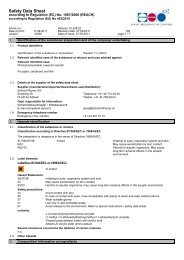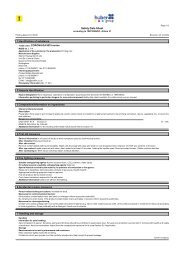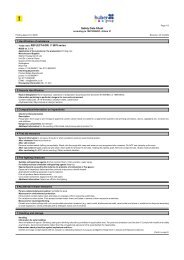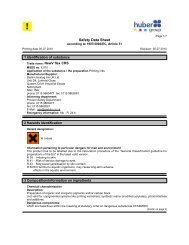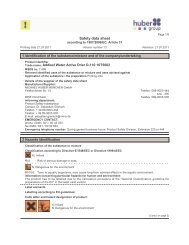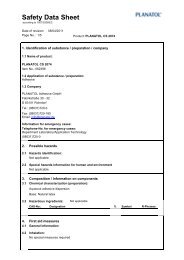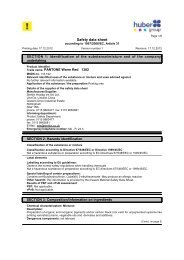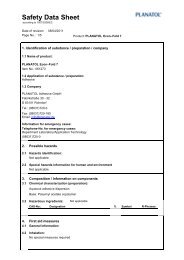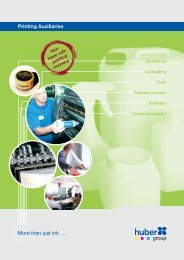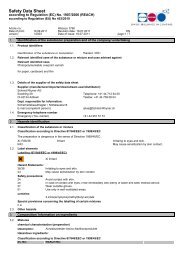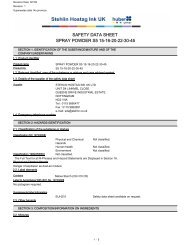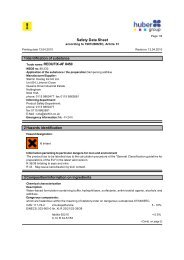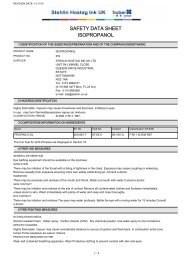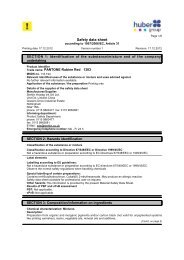Safety Data Sheet - Stehlin Hostag UK
Safety Data Sheet - Stehlin Hostag UK
Safety Data Sheet - Stehlin Hostag UK
You also want an ePaper? Increase the reach of your titles
YUMPU automatically turns print PDFs into web optimized ePapers that Google loves.
DR<br />
<strong>Safety</strong> <strong>Data</strong> <strong>Sheet</strong><br />
according to 1907/2006/EC, Article 31<br />
Page 1/3<br />
Printing date 23.12.2009 Revision: 23.12.2009<br />
* 1 Identification of substance<br />
· Trade name:Oxy Dri Plus<br />
· MSDS no. 3,736<br />
· Application of the substance / the preparation Printing inks<br />
· Manufacturer/Supplier:<br />
<strong>Stehlin</strong> <strong>Hostag</strong> Ink <strong>UK</strong> Ltd.<br />
Unit D4, Linkmel Close<br />
Queens Drive Industrial Estate<br />
Nottingham<br />
NG2 1NA<br />
phone: 0115 9860477 fax: 0115 9862681<br />
· Informing department:<br />
Product <strong>Safety</strong> Department:<br />
phone: 0115 9860477<br />
fax: 0115 9862681<br />
E-Mail : sds@stehlin.co.uk<br />
· Emergency information: Mo - Fr 24 h<br />
* 2 Hazards identification<br />
· Hazard designation: Not a hazardous substance or preparation according to EC-Directives 67/548/EEC or 1999/45/EC.<br />
· Information pertaining to particular dangers for man and environment<br />
Contains fatty acids, c6-19-branched, cobalt(2+) salts, cobalt bis(2-<br />
ethylhexanoate). May produce an allergic reaction.<br />
<strong>Safety</strong> data sheet available for professional user on request.<br />
* 3 Composition/information on ingredients<br />
· Chemical characterization<br />
· Description:<br />
Preparation from organic and inorganic pigments and/or carbon black (not valid for unpigmented systems like printing varnishes), resins, vegetable oils, mineral oils<br />
and additives.<br />
· Dangerous components:<br />
CAS: 64741-91-9 mineral oil<br />
EINECS: 265-093-4 Xn; R 65-66<br />
2.5 - 5%<br />
CAS: 64741-44-2 Distillates, petroleum, straight run middle<br />
EINECS: 265-044-7 Xn; R 53-65-66<br />
· Additional information For the wording of the listed risk phrases refer to section 16.<br />
2.5 - 5%<br />
4 First aid measures<br />
· General information In all cases of doubt, or when symptoms persist, seek medical advice.<br />
· After inhalation Remove to fresh air.<br />
· After skin contact<br />
Remove contaminated clothing immediately. Wash skin thorougly with soap and water or use recognised skin cleanser. Do NOT use solvents or thinners.<br />
· After eye contact Irrigate copiously with clean, fresh water for at least 15 minutes, holding the eyelids apart. Remove contact lenses. Obtain medical attention.<br />
· After swallowing Do NOT induce vomiting. Obtain medical attention.<br />
5 Fire fighting measures<br />
· Suitable extinguishing agents Alcohol resistant foam, CO2, powders, water spray.<br />
· For safety reasons unsuitable extinguishing agents Water jet.<br />
· Special hazards caused by the material, its products of combustion or flue gases:<br />
Exposure to hazardous decomposition products may cause a health hazard.<br />
Appropriate breathing apparatus may be required.<br />
Fire will produce dense black smoke.<br />
Cool closed containers exposed to fire with water.<br />
· Additional information Collect run-off from fire fighting.<br />
6 Accidental release measures<br />
· Person-related safety precautions: Ventilate the area.<br />
· Measures for environmental protection:<br />
If the product contaminates rivers and lakes or sewages inform respective authorities.<br />
Do not allow to enter drains. If the product contaminates rivers and lakes or sewers inform respective authorities.<br />
· Measures for cleaning/collecting:<br />
Contain and collect spillage with non-combustible absorbent material, (e.g. sand, earth, diatomaceous earth, vermiculite) and place in container for disposal according<br />
to local regulations. Clean preferably with a detergent. Avoid use of solvents.<br />
(Contd. on page 2)
DR<br />
<strong>Safety</strong> <strong>Data</strong> <strong>Sheet</strong><br />
according to 1907/2006/EC, Article 31<br />
Page 2/3<br />
Printing date 23.12.2009 Revision: 23.12.2009<br />
Trade name:Oxy Dri Plus<br />
(Contd. of page 1)<br />
7 Handling and storage<br />
· Handling<br />
· Information for safe handling:<br />
Avoid inhalation of vapour. Smoking, eating and drinking should be prohibited in application area. For personal protection see Section 8. Comply with health and safety<br />
at work laws. Avoid concentrations higher than the occupational exposure limits (see Section 8), if applicable.<br />
· Information about protection against explosions and fires:<br />
Clothes and rags contaminated with ink, lacquer or oxidatively drying oil may cause selfignition.Keep them in closed and fireproof containers.<br />
· Storage<br />
· Requirements to be met by storerooms and containers:<br />
Keep container tightly closed.No smoking.<br />
Containers which are opened must be carefully resealed and kept upright to prevent leakage.<br />
· Further information about storage conditions:<br />
Always keep in containers of the same material as the original one. Store in a dry, well ventilated place. Keep away from heat and direct sunlight. Store in accordance<br />
with the particular national regulations concerning water pollution.<br />
* 8 Exposure controls and personal protection<br />
· Additional information about design of technical systems:<br />
If relevant apply technical measures to comply with the occupational exposure limits. This can be achieved by a good general extraction and - if practically feasible - by<br />
the use of a local exhaust ventilation.<br />
· Personal protective equipment<br />
· Breathing equipment: Not necessary if room is well ventillated.<br />
· Protection of hands:<br />
For prolonged or repeated contact use gloves.<br />
Barrier creams may help to protect the exposed areas of the skin, they should however not be applied once exposure has occurred.<br />
The glove material has to be impermeable and resistant to the product/ the substance/ the preparation.<br />
· Material of gloves<br />
Applicable for example are gloves of KCL GmbH, D 36124 Eichenzell, e-mail: vertrieb@kcl.de with following<br />
specification (Laboratory test according EN 374)<br />
Recommende protective glove:<br />
Article / Name /Material / Thickness Material / Breakthrough Time Remarks<br />
Nr. 730/ Camatril Velours / Nitril / 0,4 mm Level 6 > 480 min. by full contact<br />
Nr. 743/ Dermatril / Nitril / 0,2 mm Level 2 > 30 min. by splash contact<br />
This recommendation is only for the product delivered by us and its intended purpose.<br />
· Penetration time of glove material The exact break trough time has to be found out by the manufacturer of the protective gloves and has to be observed.<br />
· Eye protection: Use safety eyewear designed to protect against splash of liquids.<br />
· Body protection:<br />
All parts of the skin should be washed after contact.<br />
Working clothes must not consist of textiles which show a dangerous melting behaviour in case of fire.<br />
* 9 Physical and chemical properties:<br />
· General Information<br />
Form:<br />
Colour:<br />
Smell:<br />
pasty<br />
according to the tradename of the product<br />
characteristic<br />
· Change in condition<br />
Boiling point/Boiling range: 101°C<br />
> 200 °C<br />
· Flash point: > 100°C<br />
· Ignition temperature: 200°C<br />
· Critical values for explosion:<br />
Lower: approx. 0.7 Vol %<br />
Upper: approx. 6.0 Vol %<br />
· Vapour pressure at 20°C: < 0.1 hPa<br />
at 20°C < 0,1 hPa<br />
· Density at 20°C 1.03 g/cm³<br />
· Solubility in / Miscibility with<br />
Water:<br />
partly or not miscible<br />
Organic solvents: < 0.06 %<br />
10 Stability and reactivity<br />
· Thermal decomposition / conditions to be avoided: Stable under recommended storage and handling conditions (see section 7).<br />
· Materials to be avoided: Keep well away from oxidising agents and strongly alkaline or strongly acid materials in order to avoid exothermic reactions.<br />
· Dangerous products of composition:<br />
Exposition to high temperatures may produce hazardous decomposition poducts such as: carbon dioxide, carbon monoxide and smoke.<br />
(Contd. on page 3)
DR<br />
<strong>Safety</strong> <strong>Data</strong> <strong>Sheet</strong><br />
according to 1907/2006/EC, Article 31<br />
Page 3/3<br />
Printing date 23.12.2009 Revision: 23.12.2009<br />
Trade name:Oxy Dri Plus<br />
(Contd. of page 2)<br />
11 Toxicological information<br />
The liquid splashed in the eyes may cause irritation and reversible damage.<br />
The Preparation is classified according to the conventional method (calculation method of the EC-directive 1999/45/EC). Repeated or prolonged contact with the<br />
preparation may cause removal of natural fat from the skin resulting in skin dryness. The product may be absorbed through the skin.<br />
12 Ecological information:<br />
The Product should not be allowed to enter drains of water courses or soil.<br />
13 Disposal considerations<br />
· Product:<br />
· Recommendation Do not allow to enter drains.<br />
· European waste catalogue 08 03 13: waste ink other than those mentioned in 08 03 12<br />
· Uncleaned packagings:<br />
· Recommendation: Not orderly emptied cans and ink remnants are special waste.<br />
14 Transport information<br />
Not classified according to transport regulations for dangerous goods (like ADR/RID, IMDG and ICAO/IATA).<br />
· Maritime transport IMDG/GGVSea:<br />
· Marine pollutant: No<br />
* 15 Regulatory information<br />
· Designation according to EC guidelines:<br />
Observe the normal safety regulations when handling chemicals<br />
Not a hazardous substance or preparation according to EC-directives 67/548/EEC or 1999/45/EC.<br />
· Special designation of certain preparations:<br />
Contains fatty acids, c6-19-branched, cobalt(2+) salts, cobalt bis(2-<br />
ethylhexanoate). May produce an allergic reaction.<br />
<strong>Safety</strong> data sheet available for professional user on request.<br />
· National regulations<br />
· Technical instructions (air):<br />
· VOC-Content (EU): 0.17 %<br />
· Mal-Code 00-3<br />
16 Other information:<br />
The information on this <strong>Safety</strong> <strong>Data</strong> <strong>Sheet</strong> is based on the pres ent state of our knowledge and on current EU and national laws. The user's working conditions are<br />
beyond our knowledge and control. It is always the res ponsibility of the user to take all neces sary steps in order to fulfil the demands laid down in the local rules and<br />
legislation. The information in this <strong>Safety</strong> <strong>Data</strong> <strong>Sheet</strong> is meant as a description of the safety requirements of our product: it is not to be considered as a guarantee of the<br />
product's properties.<br />
· Relevant R-phrases<br />
53 May cause long-term adverse effects in the aquatic environment.<br />
65 Harmful: may cause lung damage if swallowed.<br />
66 Repeated exposure may cause skin dryness or cracking.
Technical information<br />
20.15 E | 09.1999 | <strong>Sheet</strong>-fed offset | Process inks<br />
Oxy Dri Process Series<br />
for films and metallic surfaces<br />
Printing on films and film-like stocks generally requires special printing inks based predominantly<br />
or entirely on vehicles which dry by oxidation, i.e. in air. The stocks in question are usually very<br />
smooth and have no pores into which the ink or its constituents can penetrate and become physically<br />
anchored. Ink adhesion can also be impaired by release- and slip agents present on the<br />
surface, and by plasticizers.<br />
Advice to the printer<br />
• Since foil inks in most cases can dry only by oxidation, conditions are to be avoided or limited<br />
during printing which interfere with this drying mechanism:<br />
1. In wet offset, fount application should be kept to a minimum. (If ink transfer is too low, try<br />
switching to dry offset or providing additional ink consumption surfaces.)<br />
2. Use smooth-surfaced printing plates.<br />
3. Avoid working in damp, cold areas.<br />
4. The pH of the fount solution must be above 5.<br />
5. Aside fr om isopropanol, we recommend using only HYDROFIX ® -B 8013 09 as fount concentrate<br />
.<br />
• If at all possib le, the ink should contain no additives. Drying agents such as Grafo-Drier E xtra<br />
10 T 5001 may be added if necessary (no more than 3 %). Since all film-printing inks dry by<br />
oxidation, avoid long press downtimes.<br />
• When printi ng, always carefully follow the product instructions provided by the manufacturer<br />
of the stock being used, including any statements that the film in question requires mineral oilfree<br />
inks.<br />
• These in ks have a greater tendency to set off and stick. Correct delivery (i.e. as flat as pos -<br />
sible) is therefore important. Pile height depends on the type of film, but is always very limited.<br />
A powder of appropriate grain size must be applied, and only the minimum ink film thickness<br />
should be used (undercolor correction). To promote oxidative drying of the inks, make sure<br />
plenty of air is available.<br />
• Soft PVC fi lm is a particularly difficult printing stock. The plasticizer in this material can interfere<br />
with ink drying or cause resoftening of dry ink long after printing. Satisfactory results on<br />
this material can be achieved only in exceptional cases.<br />
• It is imper ative to test prior to the production run whether the ink dries satisfactorily on the substrate<br />
used and its keying and rub resistance meet the requirements of the intended use of the<br />
prints. This can best be done by printing a small preliminary run.<br />
Technical information hubergroup · 20.15 E · Page 1/2
The specific inks recommended for printing on films and foils are listed below. These are stock<br />
inks that can be ordered in any desired quantity.<br />
Fastness characteristics per DIN 16 524/25<br />
Light WS 1 Alcohol Solvent Alkali<br />
mixture<br />
Standard inks<br />
e.g. for acetate film, metallized materials, gold foil, rigid PVC, cast-coated materials<br />
Process inks<br />
Oxy Dri Plus Yellow 520 730/R 5 + + +<br />
Oxy Dri Plus Magenta 520 731/R 5 + + – 2<br />
Oxy Dri Plus Cyan 520 732/R 8 + + +<br />
Oxy Dri Plus Black 520 733/R 8 + + +<br />
Improved light fastness<br />
Oxy Dri Plus L/F Yellow 520 734/R 7 + + +<br />
Oxy Dri Plus L/F Magenta 520 735/R 7 + + +<br />
1<br />
2<br />
Printed films are often used outdoors where they are exposed to the elements. Premature bleaching may therefore<br />
occur despite the use of pigments with high DIN light fastness values. The possible chemical effects of film materials<br />
have also not been taken into account. The durability of a printed article can therefore be assessed only under actual<br />
service conditions.<br />
Not suitable for outdoor posters.<br />
Specific special ink colors (in-house or trademark colors), with the same properties as the process<br />
inks, are available by special order.<br />
Labelling<br />
German Hazardous Substances Ordinance (GefStoffV): none<br />
<strong>Safety</strong> data sheet available on request.<br />
How supplied<br />
2.5-kg vacuum tins<br />
1.0-kg va cuum tins<br />
Instructions for printing food packaging<br />
This sheetfed process series is not suitable for printing of food packaging where the substrate is<br />
in direct contact with the food and/or there are insufficient barrier properties. In this case we<br />
recommend our specially formulated low migration MGA ® to be used. More information<br />
regarding packaging for food and beverage is available on the leaftlet “printing inks for food<br />
packaging”, publsihed by the Association of Ink Manufacturers or our “information on using<br />
standard sheet-fed offset printing inks for the manufacture of food packaing” and our website<br />
www.futurepack.de.<br />
Contact addresses for advice and further information: www.hubergroup.de<br />
This Te chnical information reflects the current state of our knowledge. It is designed to inform and advise. We assume no liability for correctness.<br />
Modifications may be made in the interest of technical improvement.<br />
All product, brand and company names used in these Technical Information sheets may be registered trademarks of their respective<br />
owners.<br />
Technical information hubergroup · 20.15 E · Page 2/2




